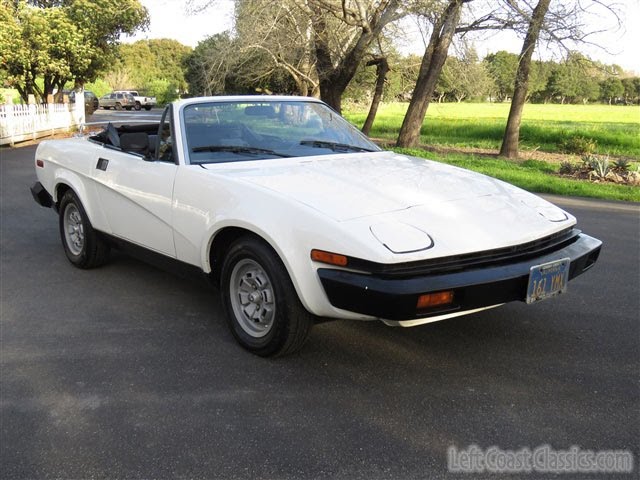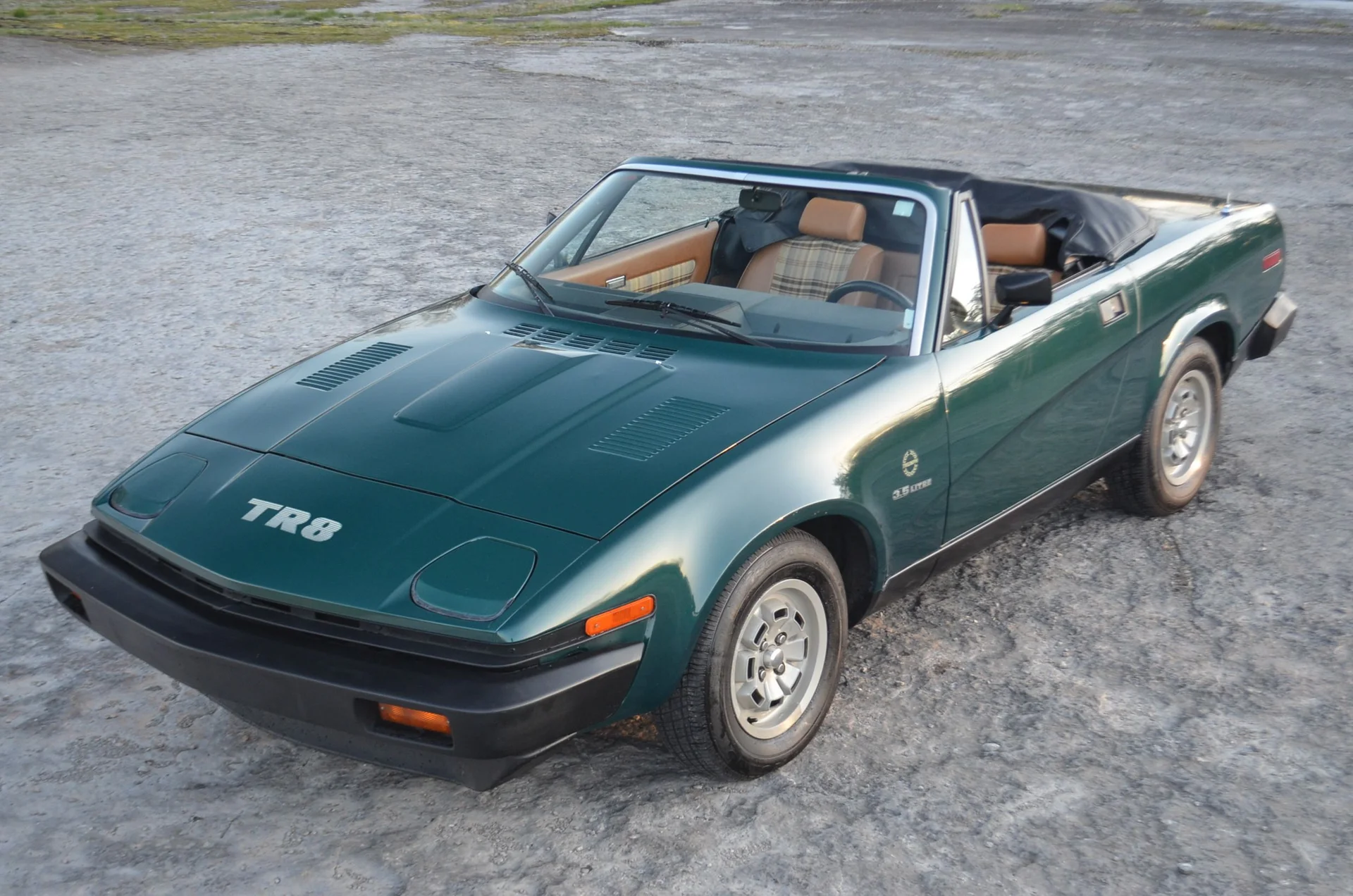Introduction
The Triumph TR7 and TR8 represent the final chapter in Triumph's legendary TR series of sports cars. Introduced in the mid-1970s, these distinctive wedge-shaped vehicles marked a significant departure from the traditional TR styling while attempting to maintain the sporting heritage that made the brand famous. This comparison explores the similarities and differences between these two iconic British sports cars, examining their design, performance, heritage, and lasting impact on automotive history.


Historical Context
The TR7, introduced in 1975, was developed during a tumultuous period for British Leyland, Triumph's parent company. Designed to meet increasingly strict US safety and emissions regulations, the TR7 represented a radical styling departure from earlier TR models. The TR8, essentially a V8-powered version of the TR7, was introduced later and initially intended primarily for the American market.
TR7 Development
The TR7 was designed by Harris Mann and launched in January 1975 in the United States, with UK sales beginning in May 1976. Initially available only as a fixed-head coupé, a convertible version was introduced in 1979. The TR7's development was influenced by anticipated US safety regulations that would have banned open-top cars (regulations that never actually materialized).
TR8 Evolution
The TR8 was conceived as a more powerful variant featuring the Rover V8 engine. While prototype development began alongside the TR7, full production of the TR8 didn't commence until 1978, with most examples destined for the American market. The TR8 was often referred to as "the English Corvette" in the US due to its combination of V8 power and European handling.
Design & Styling
Both models shared the same distinctive "wedge" shape that was radically different from previous TR models. This polarizing design represented the contemporary styling trends of the 1970s.
Exterior
The TR7 and TR8 were virtually identical in external appearance, with the TR8 distinguished mainly by subtle badging, different wheels on some models, and the presence of air vents on the bonnet of many examples. Both featured pop-up headlights, a sharply sloping bonnet, and a distinctive cut-off rear end.
Interior
The interior was modern for its time, with a driver-focused dashboard, comfortable bucket seats, and adequate equipment levels. The TR8 often featured upgraded interior trim and additional equipment befitting its status as the premium model in the range.
Technical Specifications
| Specification | Triumph TR7 | Triumph TR8 |
|---|---|---|
| Production Years | 1975-1981 | 1978-1981 |
| Engine | 1998cc (2.0L) Inline-4 | 3528cc (3.5L) V8 |
| Power Output | 105 hp (UK/EU) 92 hp (US) |
133-155 hp (depending on market/year) |
| Torque | 119 lb-ft | 174 lb-ft |
| Transmission | 4-speed manual (5-speed optional) | 5-speed manual (3-speed auto optional) |
| 0-60 mph | 9.1 seconds | 7.4 seconds |
| Top Speed | 109 mph (175 km/h) | 124 mph (200 km/h) |
| Weight | 2,285 lbs (1,036 kg) | 2,471 lbs (1,121 kg) |
| Fuel Economy | 23-27 mpg | 18-22 mpg |
| Body Styles | Coupé and Convertible | Coupé and Convertible |
| Production Numbers | Approx. 112,368 | Approx. 2,722 |
Performance & Driving Experience
TR7 Driving Dynamics
The TR7 offered adequate performance for its time, with its 2.0-liter inline-four engine providing reasonable acceleration and a top speed just over 100 mph. The handling was generally considered good, with independent suspension all around and rack-and-pinion steering providing responsive control. However, the TR7 was often criticized for lacking the raw, visceral character of earlier TR models.
TR8 Driving Experience
The TR8, with its Rover-derived 3.5-liter V8 engine, offered significantly improved performance. With 133-155 horsepower (depending on specification), the TR8 could reach 60 mph in around 7.4 seconds—impressive for the era. The additional power transformed the driving experience, making the TR8 a genuinely quick sports car with a distinctive V8 soundtrack. Despite the additional weight of the V8 engine, handling remained balanced thanks to a well-sorted chassis.
Direct Comparison
TR7 Advantages
- More affordable purchase price when new
- Better fuel economy
- Lighter weight
- More widely available (higher production numbers)
- Simpler mechanicals potentially easier to maintain
- Lower insurance costs
TR8 Advantages
- Significantly better performance
- More prestigious and exclusive
- Enhanced soundtrack from the V8 engine
- Greater collector appeal due to rarity
- More relaxed high-speed cruising
- Higher potential value appreciation
Reliability & Ownership
Common Issues
Both models suffered from various quality control issues, a problem that plagued many British Leyland products of the era. Early TR7s were particularly notorious for reliability problems, though quality improved as production moved from Liverpool to Coventry and later to Solihull.
TR7 Reliability
The TR7's four-cylinder engine was generally robust if maintained properly, but the model suffered from various electrical gremlins, cooling system issues, and body corrosion. Timing chain failures were not uncommon, and head gasket problems could occur if the cooling system was neglected.
TR8 Reliability
The TR8's Rover V8 engine is generally considered more reliable than the TR7's four-cylinder unit. This aluminum V8, derived from a Buick design, is known for its durability and ease of maintenance. However, TR8s shared many of the same electrical and body issues as the TR7.
Modern Ownership Considerations
Today, both models benefit from an active enthusiast community and good parts availability. Many common issues have been addressed through modern upgrades and improvements. The TR8, due to its rarity, generally commands significantly higher prices on the classic car market.
Legacy & Collectibility
Historical Significance
The TR7 and TR8 represent the end of an era for British sports cars. As the final models in the TR series, they bridge the gap between traditional British roadsters and the more modern sports cars that would follow. Despite their controversial styling and mixed reception when new, they have earned a place in automotive history.
Collectibility
The TR8, due to its limited production and superior performance, is generally the more collectible of the two. Good examples have seen significant appreciation in value, particularly factory convertibles. The TR7, while less valuable, offers an affordable entry point into classic British sports car ownership. Convertible variants of both models typically command a premium over the fixed-head coupés.
Community Support
Both models enjoy strong support from enthusiast clubs and specialist suppliers. This network makes ownership today more straightforward than it might otherwise be for cars of this era.
Conclusion
The Triumph TR7 and TR8 represent two sides of the same coin. The TR7, with its radical styling and adequate performance, brought the TR series into a new era but perhaps lost some of the raw sporting character that made earlier TRs so appealing. The TR8, by contrast, added the performance to match the car's striking looks, creating what many consider to be the car the TR7 should have been from the start.
While neither model may have saved Triumph from its eventual demise, both have earned a place in automotive history and in the hearts of enthusiasts. The TR8, in particular, has emerged as a genuine collector's item, appreciated for its combination of distinctive styling and V8 power. The TR7, meanwhile, continues to offer an accessible way to experience a piece of British sports car history.
For the prospective owner, the choice between the two often comes down to budget and intended use. The TR7 offers a more affordable entry point and potentially lower running costs, while the TR8 delivers superior performance and exclusivity at a higher price point. Either way, both models represent a fascinating chapter in the story of the British sports car.